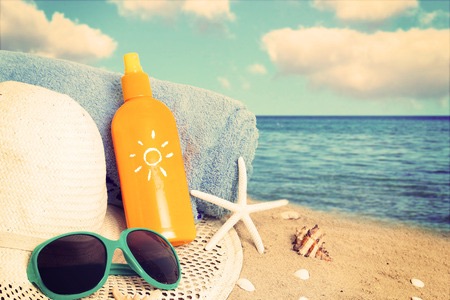
Biodegradable or reef-safe sunscreen refers to a specific sunblock formula that degrades naturally and doesn’t contain chemicals that could be harmful to the environment, specifically coral reefs. In one study, researchers found that just a small amount of sunscreen containing the ingredient oxybenzone could be enough to break down coral, causing it to lose its nutrients, bleach, and often die. Reef-safe or biodegradable sunscreens don’t contain these chemicals and are safer for the marine environment. While scientists disagree about the exact impact of chemical sunscreen on reefs, biodegradable and reef-safe sunscreen is popular among consumers who wish to reduce their overall impact on marine life.
Sunscreens typically have chemical ingredients, physical ingredients, or a combination of both. Chemical sunscreens work like a sponge, says the American Academy of Dermatology, absorbing the sun’s rays. They contain at least one of these active ingredients: oxybenzone, avobenzone, octisalate, octocrylene, homosalate, and octinoxate. In some studies, oxybenzone and octinoxate were found to harm coral reefs. Researchers are studying the impact of other chemicals.
By contrast, biodegradable (or reef-safe) sunscreen is a physical sunscreen. Physical sunscreens protect your skin by deflecting the sun’s rays. They contain the active ingredients zinc oxide and/or titanium dioxide, which are considered safer for marine life. Biodegradable sunscreens break down over time, and they don’t contain chemicals that are believed to be dangerous to coral reefs.
The labels “reef-safe” and “biodegradable” sound like a simple way to classify products that won’t harm marine life. However, there’s no exact definition for the terms, and they aren’t regulated by the government. Without regulation, manufacturers aren’t required to do testing to show that the products don’t actually harm the marine environment, Craig A. Downs, Ph.D., executive director of the nonprofit Haereticus Environmental Laboratory, tells Consumer Reports.
Even if the products are safe during testing, high concentrations could pose a problem. “Even if you have something relatively safe,” says Downs, “having 5,000 people getting into the water at a single beach, the oils from most sunscreen products can induce toxicity. “Because researchers don’t know for sure that any reef-safe sunscreen is completely harmless, it’s important to read the label and examine the ingredients before you make a purchase.
What to Look For in Sunscreen?
When shopping for sunscreen, there’s a lot of information on the label. The SPF (sun protection factor) measures how long the product will protect you from the sun’s rays. A sunscreen also may be labeled as water-resistant. If a sunscreen is labeled as “broad-spectrum” it means it protects against both UVA and UVB rays. Sunburn is mostly caused by UVB, while UVA can prematurely age your skin, causing wrinkles and age spots. The AAD suggests choosing a sunscreen that is water-resistant, offers broad-spectrum protection, and has an SPF of 30 or higher.
Up to 6,000 tons of sunscreen are estimated to wash up into coral reef areas each year, according to the NPS. The products are concentrated in popular tourist sites as the sunscreen washes off people and gloms onto the coral. A 2016 study by a team of international scientists led by Downs found that oxybenzone not only kills coral, it also causes DNA damage in adult coral and coral larvae, making it difficult for them to develop properly. The findings were published in the journal Archives of Environmental Contamination and Toxicology.
“If a coral is exposed to a large concentration of benzophenone-3 (oxybenzone) it might bleach. However, unless you’re in a very crowded and very small bay where people are constantly reapplying sunscreen, the concentration in the water won’t be consistently high enough to bleach any corals,” he says. Other researchers contend that the chemicals do add up and eventually cause harm, even in small concentrations. If your goal is to protect marine life and you have your pick of sunscreens, it’s a safe bet to opt for a biodegradable sunscreen without potentially harmful ingredients.
Matter referenced:
Mary Jo DiLonardo (2020, July). Reef Safe & Biodegradable Sunscreen: What you should Know? cited from: https://www.treehugger.com/reef-safe-biodegradable-sunscreen-5069839?utm_campaign=treehugger&utm_medium=email&utm_source=cn_nl&utm_content=20790131&utm_term=
By: Dr. Bhawana Asnani.
Happy to see Reviews, Additions, Suggestions and Comments, further.

Hi there! This post couldn’t be written any better! Reading through this post reminds me of my previous room mate! He always kept talking about this. I will forward this article to him. Pretty sure he will have a good read. Thank you for sharing!